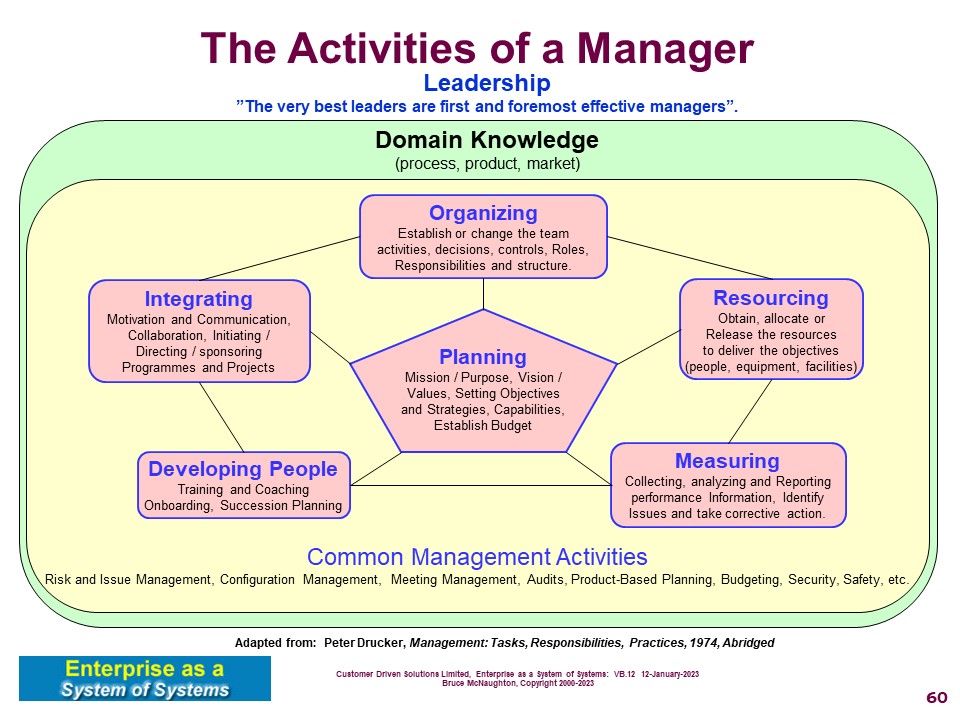Every manager is the architect of their team. (at all levels)
The work of a manager of a Team is generally described using the following activities of a manager as shown in the picture below:

Managing is a set of activities carried out by a manager of a team or a self managing team.
These activities for part of the management capabilities used by the manager to create the environment for the team to deliver their team's purpose.
The remaining capabilities used by the team are realized by the manager. The manager requires domain knowledge to establish these team specific capabilities. The domain knowledge relates directly to the contribution of the team within the organization.
These activities or similar have been identified by various authors such as Peter Drucker, Henry Mintzberg and the origin of this list goes back to the 1920s.
There are a number of supporting Common Management Activities that are performed while doing the above. These are becoming much more important to ensure sustainable management practice.
Managers can also bring something extra to carrying out these activities. Leadership emerges based upon the way the activities are carried out. This is based upon their skills, knowledge, experience attitudes, behaviors and beliefs of the manager.
The activities of a manager are ‘recursive’ and are carried out at all levels within an organization.
The manager establishes a Management Plan for the team or set of organizations using the Planning System.
The key process is: Team Performance Management
See System Element: Plans and the Concepts for Planning
- Activity Analysis
- Decision Analysis
- Relationship Analysis
- Identify teams
- Identify, Jobs, Roles and Responsibilities within the Team
- Identify Business Process Requirements (If necessary)
- Identify Team Requirements [Outline Plan](if necessary)
- Organization Design: Organizing.
- Recruit and Select and Release People
- Allocate and Release resources (assets, facilities, etc)
- Procurement: Resourcing (things / contracts)
- Develop People: Recruit and Select, Release, Monitor accomplishments, Develop People.
Integrating is an activity of 'Synthesis' to ensure that the team fits properly in the wider organisation and the contributes to the overall purpose of the organisation.
- Review artefacts
- Sponsor / Direct Projects.
- Collaborate with other teams
- Manage Processes (when necessary)
- Sponsor and Establish New Business Process(s)
- Sponsor and Establish New Team(s)
- Programme Management Process Design Pattern: All: Temporary Large Changes
- Project Management: All: Temporary work
- Continual Management System Improvement: Planning, Review (if responsible)
- Collect measurement data
- Contribute to measurement repository
- Report on measurement results
- Initiate corrective action if necessary
- Develop People: Recruit and Select, Release, Monitor accomplishments, Develop People.
- Establish individual Objectives
- Establish development plans
- Monitor accomplishments
- Establish Succession Plans
- Develop People: Recruit and Select, Release, Monitor accomplishments, Develop People.
See the Process: Common Management Activities
Examples are:
- Risk and Issue Management
- Configuration Management
- Meeting Management
- Communication
- Product-Based Planning
- Auditing
- Review and Specification QC
- Coaching
- Measurement
Domain knowledge relates to the deep understanding of the specialist activities in a particular area. These areas could be any of the areas within the organization such as:
- Marketing
- Innovation
- Product or Service Delivery (Operations)
- Management
in addition, supplier and customer knowledge is useful.
Domain knowledge allows the manager to carry out the activities with much more understanding of the work of the team members and the rest of the organization.
- Understanding of the work of the team. and the organization as a whole.
Leadership and Management tend to be two sides of the same coin. The best leaders are also effective managers.
The leadership activities are:
-
Future
-
Engage
-
Deliver
Leadership attributes tend to be:
-
Inspirational
-
Visionary
-
Integrating
-
Focused
-
Caring
-
Teaching
Self Managing Teams share the activities of a manager. In this way, the team takes responsibilities for all of the activities of a manager.
Typically, a team is formed by a manager and then the manager develops their staff to take responsibility for delegated activities of a manager.
This type of self managing teams is found in Scrum (Agile) Teams where individuals take responsibility for activities that they are trained to carry out.